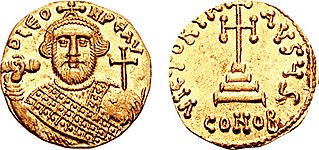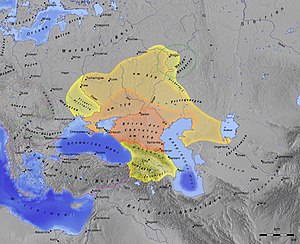1000 (M) was a leap year starting on Monday of the Julian calendar, the 1000th year of the Common Era (CE) and Anno Domini (AD) designations, the 1000th and last year of the 1st millennium, the 100th and last year of the 10th century, and the 1st year of the 1000s decade. As of the start of 1000, the Gregorian calendar was 5 days ahead of the Julian calendar, which was the dominant calendar of the time.
The 730s decade ran from January 1, 730, to December 31, 739.
The 720s decade ran from January 1, 720, to December 31, 729.

Year 710 (DCCX) was a common year starting on Wednesday of the Julian calendar. The denomination 710 for this year has been used since the early medieval period, when the Anno Domini calendar era became the prevalent method in Europe for naming years.
The 640s decade ran from January 1, 640, to December 31, 649.
The 650s decade ran from January 1, 650, to December 31, 659.
The 670s decade ran from January 1, 670, to December 31, 679.
The 690s decade ran from January 1, 690, to December 31, 699.
The 560s decade ran from January 1, 560, to December 31, 569.
The 570s decade ran from January 1, 570, to December 31, 579.

Year 630 (DCXXX) was a common year starting on Monday of the Julian calendar. The denomination 630 for this year has been used since the early medieval period, when the Anno Domini calendar era became the prevalent method in Europe for naming years.
Year 605 (DCV) was a common year starting on Friday of the Julian calendar. The denomination 605 for this year has been used since the early medieval period, when the Anno Domini calendar era became the prevalent method in Europe for naming years.

Year 743 (DCCXLIII) was a common year starting on Tuesday of the Julian calendar. The denomination 743 for this year has been used since the early medieval period, when the Anno Domini calendar era became the prevalent method in Europe for naming years.

Year 780 (DCCLXXX) was a leap year starting on Saturday of the Julian calendar, the 780th year of the Common Era (CE) and Anno Domini (AD) designations, the 780th year of the 1st millennium, the 80th year of the 8th century, and the 1st year of the 780s decade. The denomination 780 for this year has been used since the early medieval period, when the Anno Domini calendar era became the prevalent method in Europe for naming years.

Year 661 (DCLXI) was a common year starting on Friday of the Julian calendar. The denomination 661 for this year has been used since the early medieval period, when the Anno Domini calendar era became the prevalent method in Europe for naming years.

Year 655 (DCLV) was a common year starting on Thursday of the Julian calendar. The denomination 655 for this year has been used since the early medieval period, when the Anno Domini calendar era became the prevalent method in Europe for naming years.

Year 657 (DCLVII) was a common year starting on Sunday of the Julian calendar. The denomination 657 for this year has been used since the early medieval period, when the Anno Domini calendar era became the prevalent method in Europe for naming years.

Year 672 (DCLXXII) was a leap year starting on Thursday of the Julian calendar. The denomination 672 for this year has been used since the early medieval period, when the Anno Domini calendar era became the prevalent method in Europe for naming years.

Year 695 (DCXCV) was a common year starting on Friday of the Julian calendar. The denomination 695 for this year has been used since the early medieval period, when the Anno Domini calendar era became the prevalent method in Europe for naming years.

Year 736 (DCCXXXVI) was a leap year starting on Sunday of the Julian calendar, the 736th year of the Common Era (CE) and Anno Domini (AD) designations, the 736th year of the 1st millennium, the 36th year of the 8th century, and the 7th year of the 730s decade. The denomination 736 for this year has been used since the early medieval period, when the Anno Domini calendar era became the prevalent method in Europe for naming years.











